Sunrun Bundle
How Does Sunrun Thrive in the Solar Energy Market?
Sunrun has revolutionized the Sunrun SWOT Analysis landscape, making solar energy accessible to homeowners with innovative service plans. They design, install, and maintain solar panel systems, offering financing options and energy management solutions. With over a million customers, including nearly 900,000 subscribers as of late 2024, Sunrun is a leader in the residential solar market.
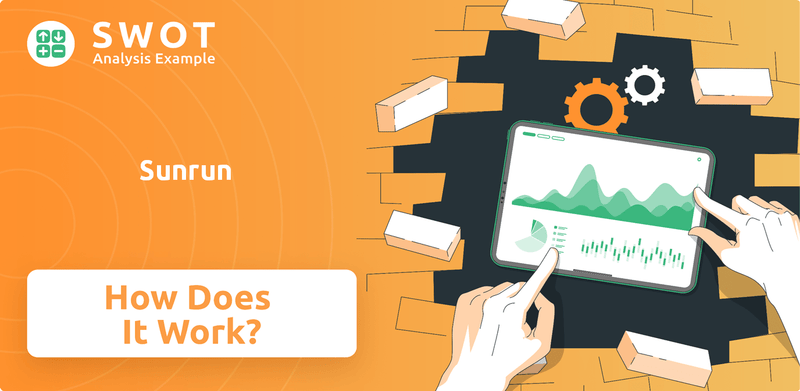
Sunrun's success hinges on understanding the intricacies of Sunrun SWOT Analysis, from how their solar panel leasing works to the benefits of their solar panel systems. As the global solar PV market continues to grow, with expectations of 10% growth in 2025, understanding Sunrun's financial performance, including factors like Sunrun cost and customer service reviews, is essential for anyone interested in the future of solar energy and residential solar.
What Are the Key Operations Driving Sunrun’s Success?
Sunrun delivers value by offering comprehensive residential solar, battery storage, and energy management services. The company primarily operates through a 'solar as a service' model, which allows homeowners to access solar energy with little to no upfront cost. Customers either pay for the energy produced monthly or opt for direct purchase of solar systems. This approach makes solar energy more accessible.
The core of Sunrun's operations includes the design, installation, financing, and maintenance of solar panel and battery storage systems. Their processes cover the entire lifecycle, from customer acquisition and system design to installation, ongoing monitoring, and repairs. The company sources components like solar modules, inverters, and batteries, with about half of the solar modules and all inverters and batteries coming from the United States. However, their battery suppliers face potential cost impacts from tariffs on Chinese supply chains.
Sunrun enhances its value proposition with innovative solutions such as the Sunrun Flex offering. This allows subscribers to increase their use of self-produced energy without adding new panels or batteries. Flex customers pay a monthly fee and participate in grid services programs, enabling their batteries to support the grid and help avoid peak utility rates. This results in benefits like energy independence, reduced electricity bills, and reliable home power during outages. For more details on who benefits from Sunrun's offerings, you can explore the Target Market of Sunrun.
Sunrun provides solar energy systems, including solar panel installation and battery storage. They offer financing options and ongoing maintenance. Their services aim to provide homeowners with clean energy solutions.
The company's operations cover the full lifecycle of solar energy systems. This includes everything from initial customer contact and system design to installation, monitoring, and maintenance. Their supply chain is primarily based in the US.
Sunrun offers energy independence, reduced electricity bills, and reliable power during outages. The 'solar as a service' model eliminates high upfront costs. They also provide innovative solutions like Sunrun Flex.
As of September 30, 2024, Sunrun had over 1 million customers and a total networked solar capacity of about 7.3 GW and 2.1 GWh of battery capacity. By the end of 2024, they installed over 156,000 solar and storage systems, representing over 2.5 GWh of networked storage capacity, and increased its storage attachment rate to 62% of new customers.
Sunrun's services offer significant advantages to homeowners, including financial savings and energy security. Customers can reduce their electricity bills and gain independence from the grid.
- Reduced electricity bills through solar energy generation.
- Energy independence and resilience with battery storage.
- Access to clean and sustainable energy sources.
- Simplified financing options with little to no upfront Sunrun cost.
Sunrun SWOT Analysis
- Complete SWOT Breakdown
- Fully Customizable
- Editable in Excel & Word
- Professional Formatting
- Investor-Ready Format
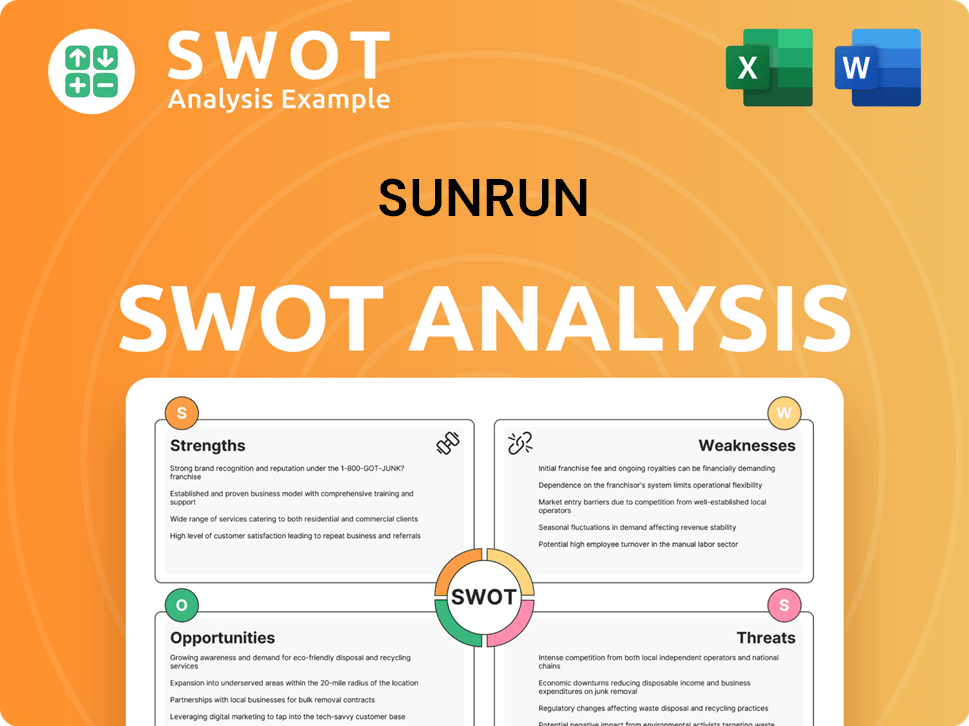
How Does Sunrun Make Money?
Sunrun's financial model is built on diverse revenue streams, primarily centered around customer agreements and incentives, alongside the direct sale of solar energy systems and products. This multifaceted approach allows the company to capture value from various aspects of the solar energy market. The company's performance in 2024 and early 2025 reflects the evolving dynamics of the residential solar market, with shifts in revenue sources and strategic initiatives.
In 2024, Sunrun's total revenue was $2.04 billion, reflecting a 10% decrease compared to 2023. However, the composition of this revenue reveals significant shifts. Customer agreements and incentives revenue increased by 27% year-over-year to $1.51 billion in 2024. This growth was offset by a 50% decrease in solar energy systems and product sales revenue, which stood at $532.5 million in 2024. This shift indicates a growing emphasis on long-term customer relationships and recurring revenue streams.
For the first quarter of 2025, Sunrun reported a total revenue of $504.27 million, a 10% increase compared to the same period in 2024. Customer agreements and incentives revenue in Q1 2025 was $402.9 million, a 25% increase from Q1 2024. The company's annual recurring revenue from subscribers was approximately $1.6 billion as of December 31, 2024.
Sunrun employs several strategies to monetize its offerings, with a strong focus on its 'Solar-as-a-Service' model. This model allows customers to lease Solar panels and pay monthly subscription fees for the energy produced, often with minimal upfront costs. This approach fosters long-term customer relationships and predictable revenue streams. Furthermore, Sunrun leverages federal and state renewable energy incentives, which can significantly reduce the Sunrun cost for customers and improve the company's profitability. The company also benefits by selling excess energy produced by Solar energy systems back to the grid.
- Solar-as-a-Service Model: Customers lease solar equipment and pay monthly fees.
- Incentives: Utilizes federal and state renewable energy incentives.
- Grid Services: Enrolls customers in programs to support the grid.
- Sunrun Flex: Offers flexible energy usage at locked-in rates, generating recurring revenue.
Sunrun PESTLE Analysis
- Covers All 6 PESTLE Categories
- No Research Needed – Save Hours of Work
- Built by Experts, Trusted by Consultants
- Instant Download, Ready to Use
- 100% Editable, Fully Customizable
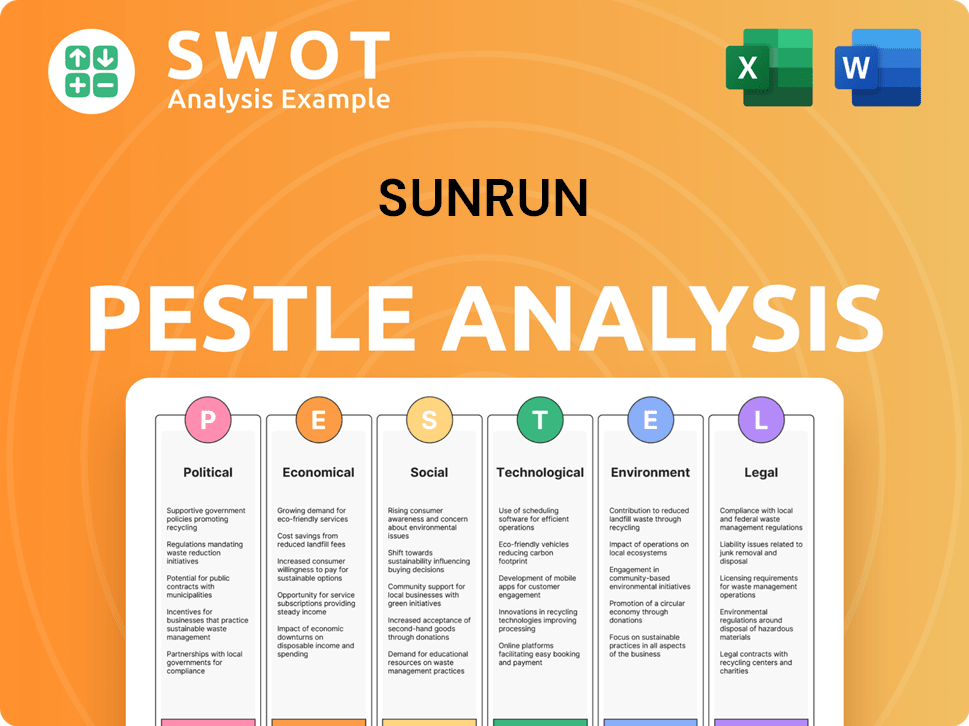
Which Strategic Decisions Have Shaped Sunrun’s Business Model?
Let's explore the key milestones, strategic moves, and competitive edge of Sunrun, a leading player in the residential solar and battery storage market. The company has demonstrated significant growth and adaptability in a dynamic industry, navigating challenges and capitalizing on opportunities to solidify its position. Understanding these aspects is crucial for anyone interested in the company's trajectory and its impact on the solar energy landscape.
Sunrun's journey includes achieving notable financial results and strategic adjustments to maintain its leadership. The company's focus on innovation, customer acquisition, and operational efficiency has been key to its success. Moreover, Sunrun's commitment to providing clean energy solutions and its ability to leverage technological advancements have set it apart in a competitive market.
Sunrun's progress and strategic decisions are critical to understanding its position in the solar energy sector. For a deeper dive into the company's origins, you can check out Brief History of Sunrun.
A significant milestone for Sunrun was surpassing one million customers in 2024, becoming the first storage-plus-solar company to achieve this. This milestone was accompanied by generating meaningful financial results, including record unit margins. In Q1 2025, Sunrun delivered its fourth consecutive quarter of positive cash generation, achieving $56 million.
Sunrun has adapted to market challenges by focusing on margin-focused growth and optimizing its product mix. The company is building a strong, domestically-focused supply chain. Sunrun expects U.S. import tariffs to raise its costs by 3% to 7% in 2025, but anticipates that any adverse changes to tax and tariff policy will also impact utilities.
Sunrun's competitive advantages stem from its pioneering 'solar as a service' business model, which makes clean energy accessible with minimal upfront costs, its leading customer acquisition platform, and extensive financing experience. The company's large fleet of residential solar and battery systems allows it to provide valuable energy resources to utilities and grid operators through virtual power plant (VPP) programs.
Sunrun reduced its parent debt by $27 million in Q1 2025, ending the quarter with $605 million in unrestricted cash. The company's increasing storage attachment rate reached a record high of 69% in Q1 2025, up from 50% in Q1 2024.
Sunrun's success is built on key milestones, strategic adaptations, and a strong competitive position. The company's focus on customer acquisition and financial performance has been critical.
- Sunrun's VPP program, such as CalReady in California, has grown significantly, with approximately 75,000 batteries.
- The company's storage attachment rate reached a record high of 69% in Q1 2025.
- Sunrun continues to innovate in the residential solar and battery storage market.
- Sunrun's ability to adapt to new trends and technology shifts is evident in its increasing storage attachment rate.
Sunrun Business Model Canvas
- Complete 9-Block Business Model Canvas
- Effortlessly Communicate Your Business Strategy
- Investor-Ready BMC Format
- 100% Editable and Customizable
- Clear and Structured Layout
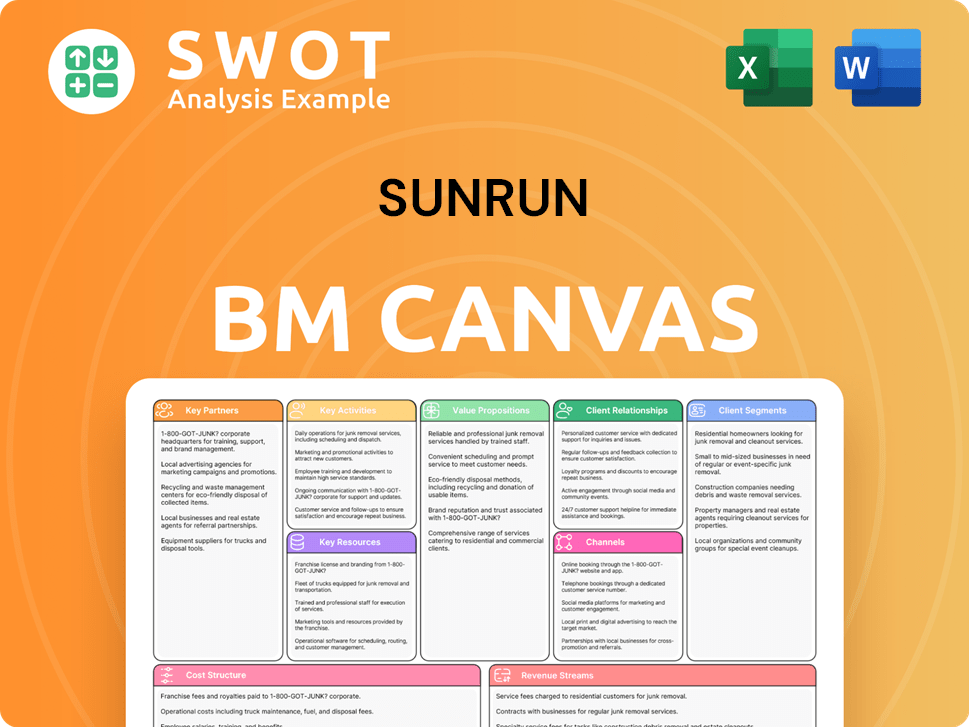
How Is Sunrun Positioning Itself for Continued Success?
Let's examine the industry position, risks, and future outlook for Sunrun. The company holds a leading position in the U.S. residential solar and battery storage market. Understanding these factors is crucial for anyone considering investing in or utilizing their services, such as Sunrun's growth strategy.
Sunrun's performance is closely tied to the dynamics of the renewable energy sector, influenced by policy changes, technological advancements, and market trends. This analysis will provide insights into the company's current standing and its prospects moving forward.
In the fourth quarter of 2024, Sunrun accounted for approximately 19% of new U.S. solar installations and 45% of new U.S. energy storage installations. Sunrun Inc.'s market share in the Industrial Machinery and Components Industry was 94.71% as of Q1 2025, based on total revenue. The company had over 1 million customers as of December 31, 2024.
Regulatory changes and policy uncertainty pose significant risks. U.S. import tariffs are expected to increase costs by 3% to 7% in 2025, primarily due to higher battery prices. The residential solar market is predicted to contract slightly in 2025. High customer acquisition costs, increasing by 8% year-over-year to $0.87/Wdc in Q4 2024, also impact installers.
Sunrun is focusing on margin-focused growth and prudent balance sheet management. Contracted net value creation is expected to range from $650 million to $850 million for the full year 2025, representing a 9% growth at the midpoint compared to 2024. Cash generation is projected between $200 million and $500 million for 2025.
The company anticipates its aggregate subscriber value to range from $5.7 billion to $6.0 billion for the full year 2025, a 14% year-over-year increase at the midpoint. Sunrun is adapting with its new Flex product, which has seen over 10,000 customers select it in pilot markets. Virtual power plant programs, such as CalReady, are expanding, providing grid support.
These initiatives and market dynamics shape the outlook for Sunrun in the competitive solar energy landscape. Understanding these factors is important for assessing the company's potential.
- The company's ability to manage costs, including customer acquisition costs, is crucial.
- The success of the Flex product and virtual power plant programs will be key drivers of future revenue.
- Policy changes, such as those impacting tax credits and tariffs, will continue to significantly influence the company's performance.
- The overall growth of the solar energy market, including both residential solar and battery storage, will be a major factor.
Sunrun Porter's Five Forces Analysis
- Covers All 5 Competitive Forces in Detail
- Structured for Consultants, Students, and Founders
- 100% Editable in Microsoft Word & Excel
- Instant Digital Download – Use Immediately
- Compatible with Mac & PC – Fully Unlocked
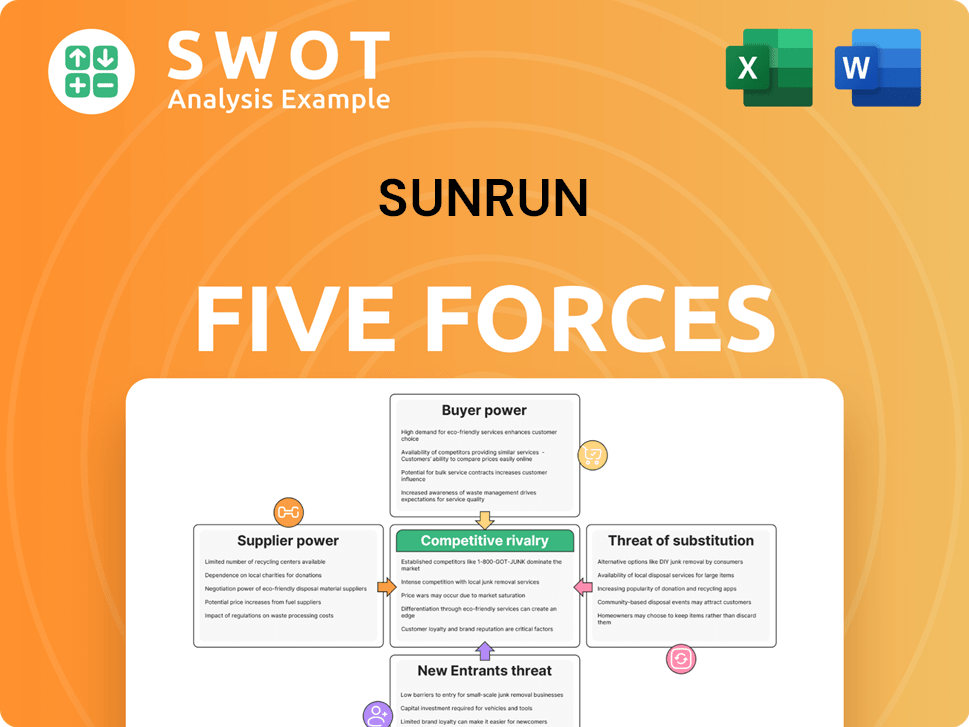
Related Blogs
- What are Mission Vision & Core Values of Sunrun Company?
- What is Competitive Landscape of Sunrun Company?
- What is Growth Strategy and Future Prospects of Sunrun Company?
- What is Sales and Marketing Strategy of Sunrun Company?
- What is Brief History of Sunrun Company?
- Who Owns Sunrun Company?
- What is Customer Demographics and Target Market of Sunrun Company?
Disclaimer
All information, articles, and product details provided on this website are for general informational and educational purposes only. We do not claim any ownership over, nor do we intend to infringe upon, any trademarks, copyrights, logos, brand names, or other intellectual property mentioned or depicted on this site. Such intellectual property remains the property of its respective owners, and any references here are made solely for identification or informational purposes, without implying any affiliation, endorsement, or partnership.
We make no representations or warranties, express or implied, regarding the accuracy, completeness, or suitability of any content or products presented. Nothing on this website should be construed as legal, tax, investment, financial, medical, or other professional advice. In addition, no part of this site—including articles or product references—constitutes a solicitation, recommendation, endorsement, advertisement, or offer to buy or sell any securities, franchises, or other financial instruments, particularly in jurisdictions where such activity would be unlawful.
All content is of a general nature and may not address the specific circumstances of any individual or entity. It is not a substitute for professional advice or services. Any actions you take based on the information provided here are strictly at your own risk. You accept full responsibility for any decisions or outcomes arising from your use of this website and agree to release us from any liability in connection with your use of, or reliance upon, the content or products found herein.